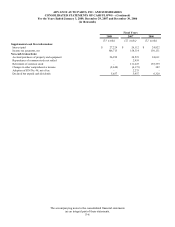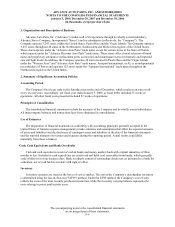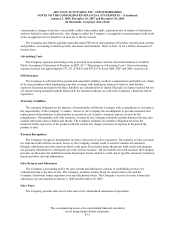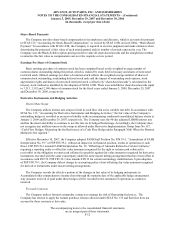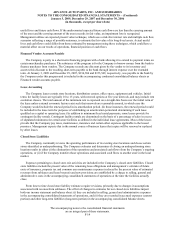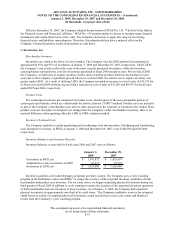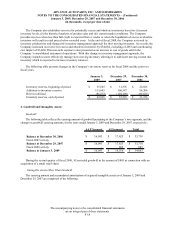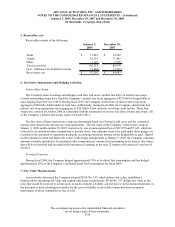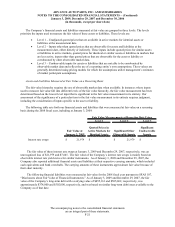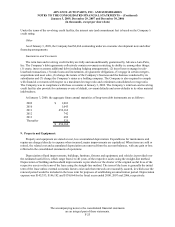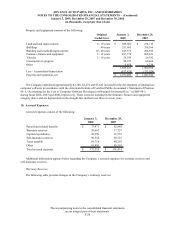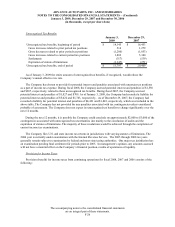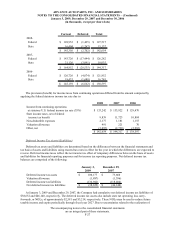Advance Auto Parts 2008 Annual Report Download - page 71
Download and view the complete annual report
Please find page 71 of the 2008 Advance Auto Parts annual report below. You can navigate through the pages in the report by either clicking on the pages listed below, or by using the keyword search tool below to find specific information within the annual report.
ADVANCE AUTO PARTS, INC. AND SUBSIDIARIES
NOTES TO THE CONSOLIDATED FINANCIAL STATEMENTS – (Continued)
January 3, 2009, December 29, 2007 and December 30, 2006
(in thousands, except per share data)
The accompanying notes to the consolidated financial statements
are an integral part of these statements.
F-17
Effective December 30, 2007, the Company adopted the provisions of SFAS No. 159, “The Fair Value Option
for Financial Assets and Financial Liabilities.” SFAS No. 159 permits entities to choose to measure many financial
instruments and certain other items at fair value. The Company elected not to apply fair value on its existing
financial assets and liabilities upon adoption. Therefore, this adoption did not have a material effect on the
Company’s financial position, results of operations or cash flows.
3. Inventories, net:
Merchandise Inventory
Inventories are stated at the lower of cost or market. The Company uses the LIFO method of accounting for
approximately 95% and 93% of inventories at January 3, 2009 and December 29, 2007, respectively. Under LIFO,
the Company’s cost of sales reflects the costs of the most recently purchased inventories, while the inventory
carrying balance represents the costs for inventories purchased in fiscal 2008 and prior years. Prior to fiscal 2008,
the Company’s overall costs to acquire inventory for the same or similar products had been decreasing in recent
years due to the Company’s significant growth. However, in fiscal 2008, the current cost to replace inventory was
greater under LIFO. As a result of utilizing LIFO, the Company recorded an increase to cost of sales of $12,555 for
its fiscal year ended 2008 while having recorded a reduction to cost of sales of $11,005 and $9,978 for fiscal years
ended 2007 and 2006, respectively.
Product Cores
The remaining inventories are comprised of product cores, which consist of the non-consumable portion of
certain parts and batteries, which are valued under the first-in, first-out ("FIFO") method. Product cores are included
as part of the Company’s merchandise costs and are either passed on to the customer or returned to the vendor. Since
product cores are not subject to frequent cost changes like the Company’s other merchandise inventory, there is no
material difference when applying either the LIFO or FIFO valuation method.
Inventory Overhead Costs
The Company capitalizes certain purchasing and warehousing costs into inventory. Purchasing and warehousing
costs included in inventory, at FIFO, at January 3, 2009 and December 29, 2007, were $104,594 and $107,068,
respectively.
Inventory Balances and Inventory Reserves
Inventory balances at year-end for fiscal years 2008 and 2007 were as follows:
January 3, December 29,
2009 2007
Inventories at FIFO, net 1,541,871$ 1,435,697$
Adjustments to state inventories at LIFO 81,217 93,772
Inventories at LIFO, ne
t
1,623,088$ 1,529,469$
Inventory quantities are tracked through a perpetual inventory system. The Company uses a cycle counting
program in all distribution centers and PDQs® to ensure the accuracy of the perpetual inventory quantities of both
merchandise and product core inventory. For our retail stores, we began completing physical inventories during our
third quarter of fiscal 2008 in addition to cycle counting to ensure the accuracy of the perpetual inventory quantities
of both merchandise and core inventory in these locations. As of January 3, 2009, the Company had completed
physical inventories in approximately one-third of its retail stores. The Company establishes reserves for estimated
shrink based on results of completed physical inventories, actual results from recent cycle counts and historical
results from the Company’s cycle counting program.



